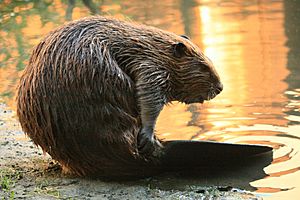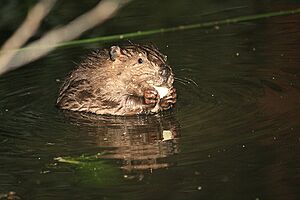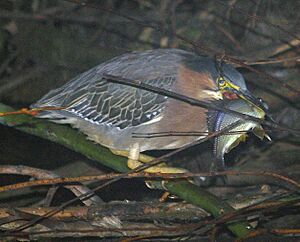Martinez beavers facts for kids
The Martinez beavers are a special family of North American beavers. They live in Alhambra Creek right in downtown Martinez, California. Martinez is famous as the home of John Muir, a well-known naturalist. Now, it's also known across the country for how it used beavers to help restore a city creek.
In late 2006, a male and female beaver arrived in Alhambra Creek. They soon had four baby beavers, called kits. The city of Martinez first decided to remove the beavers. But local nature lovers formed a group called Worth a Dam. Thanks to their efforts, the city changed its mind. Since then, many different kinds of wildlife have returned to Alhambra Creek. This is likely because the beavers' dams have created new habitats.
Contents
Alhambra Creek: The Beavers' Home

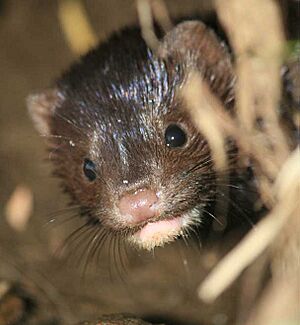

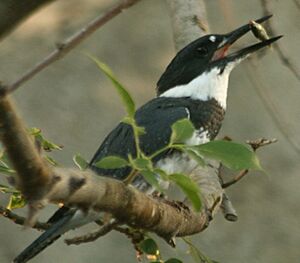
In late 2006, two beavers made Alhambra Creek their home. The creek flows right through the city of Martinez. The beavers built a large dam that was 30 feet wide and once 6 feet high! They also chewed on many willow trees and other plants. These plants were part of a big flood-control project the city had finished earlier.
A Community Stands Up for Beavers
In November 2007, the city worried that the dam might cause flooding. They decided the beavers needed to be removed. The California Department of Fish and Game (DFG) usually does not allow moving beavers. So, the only option seemed to be to remove them permanently.
Many residents were very upset. They held a "beaver vigil" and a rally. News cameras and curious people came to downtown Martinez. Because of this strong public reaction, the city got a special permission from the DFG. The DFG even offered to pay for the beavers to be moved safely.
This last-minute decision helped calm things down. But people still wanted the beavers to stay. In a city council meeting, many people spoke. They praised the city for getting the special permission. But they also asked the city to find better ways to control floods without harming the beavers. Many groups, like the Sierra Club and the Humane Society, offered to help.
Solving the Flood Problem
After the meeting, the mayor created a special group to help the beavers. The city hired an expert named Skip Lisle. He installed a special "flow device" in the beaver dam. This device is a pipe that goes through the dam. It helps control the water level in the pond so it doesn't get too high. As of 2013, this flow device was working very well.
Beavers as Nature's Engineers
Beavers are known as a "keystone species." This means they play a very important role in their environment. They change the landscape in ways that help many other plants and animals. The Martinez beavers have changed Alhambra Creek from a small stream into many dams and ponds.
This change has brought back many animals. Steelhead trout and river otters returned in 2008. Mink returned in 2009. In 2010, a green heron was seen catching a tule perch. This was the first time a tule perch had been recorded in Alhambra Creek! Also, a pair of hooded merganser ducks arrived in December 2010. The original beaver parents had baby beavers every year since they arrived in 2006.
Remembering the Beavers
In November 2009, the Martinez City Council approved a special mural. This mural, made of 81 tiles, was placed on the Escobar Street bridge. Schoolchildren created the mural. The Worth a Dam group donated it to remember the beavers and other wildlife in Alhambra Creek.
In June 2010, the mother beaver died from a broken tooth. She had just had triplets that year, and quadruplets in the three years before. In 2011, a new adult female beaver arrived at the creek. She later gave birth to three more beavers. Sadly, heavy rains in March 2011 caused flooding. This washed away the beaver lodge and all four dams on Alhambra Creek.
In September 2011, a local artist named Mario Alfaro was painting a mural about the city's history. City officials told him to paint over a beaver he had included in his artwork. He did so, and also painted over his own name as a quiet protest.
In 2014, there were seven beavers living in the creek. From 2006 to 2014, a total of 22 beavers lived there at different times. Eight of them died, seven were still living there, and the fate of the other seven is unknown.
Since 2008, Martinez has held an annual Beaver Festival. It celebrates the beavers and their positive impact on the community and environment.
History of Beavers in California
The Martinez beavers likely came from the Sacramento–San Joaquin River Delta. Long ago, before the "California Fur Rush" in the late 1700s and early 1800s, this Delta area probably had more beavers than anywhere else in North America.
The fur trade in California was very important. It helped open up the West, especially the San Francisco Bay Area, to trade with the rest of the world. Many countries, like Spain, France, England, Russia, and America, were involved in the fur trade before 1825. They caught huge numbers of beavers, river otters, and other animals.
When the fur trade along the coast slowed down, people focused on California's inland animals. Between 1826 and 1845, the Hudson's Bay Company sent groups every year into the Sacramento and San Joaquin valleys. These trips were very profitable because they caught so many animals. The beaver (Castor canadensis) was one of the most valuable animals.
Thomas McKay once reported that the Hudson's Bay Company caught 4,000 beaver skins near San Francisco Bay in one year. These skins were worth about $4 each at the time.
In 1840, an explorer named Captain Thomas J. Farnham wrote that beavers were very common near the mouths of the Sacramento and San Joaquin rivers. He said there were hundreds of small, "rush-covered" islands where beavers lived. Farnham had traveled widely in North America. He said, "There is probably no spot of equal extent in the whole continent of America which contains so many of these muchsought animals."


